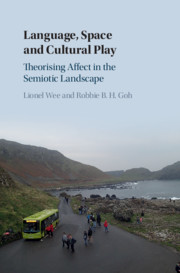Book contents
- Language, Space, and Cultural Play
- Language, Space, and Cultural Play
- Copyright page
- Contents
- Figures
- Acknowledgments
- 1 Introduction
- 2 Theorizing Affect in the Semiotic Landscape
- 3 Kawaii in the Semiotic Landscape
- 4 Reverencing the Landscape
- 5 Romancing the Landscape
- 6 “Friendly Places”
- 7 The Affective Regime of Luxury and Exclusivity
- 8 Affecting the Digital Landscape
- 9 Conclusion
- References
- Index
6 - “Friendly Places”
Published online by Cambridge University Press: 30 October 2019
- Language, Space, and Cultural Play
- Language, Space, and Cultural Play
- Copyright page
- Contents
- Figures
- Acknowledgments
- 1 Introduction
- 2 Theorizing Affect in the Semiotic Landscape
- 3 Kawaii in the Semiotic Landscape
- 4 Reverencing the Landscape
- 5 Romancing the Landscape
- 6 “Friendly Places”
- 7 The Affective Regime of Luxury and Exclusivity
- 8 Affecting the Digital Landscape
- 9 Conclusion
- References
- Index
Summary
This chapter addresses the issue of boundaries: how are the boundaries established between one site where a particular kind of affect is being fostered and another site where some other affect is either encouraged or where the affect fostered by the former site is no longer a relevant concern? The chapter begins with a brief consideration of various attempts to demarcate specific sites as ‘friendly’. This gives a sense of what the semiotics of conviviality might look like. The latter half of the chapter comprises a detailed case study of a ‘dementia-friendly’ neighborhood in Singapore.
- Type
- Chapter
- Information
- Language, Space and Cultural PlayTheorising Affect in the Semiotic Landscape, pp. 102 - 126Publisher: Cambridge University PressPrint publication year: 2019

